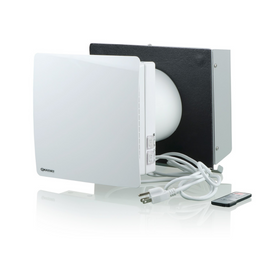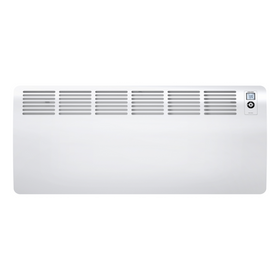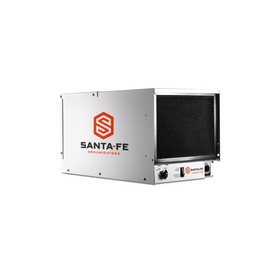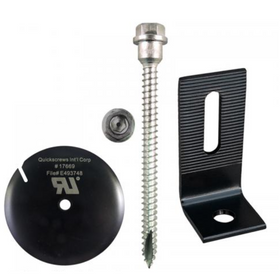
Net Positive Home in Saint Paul, Minnesota
Last Updated: Feb 11, 2025When Muffi and Tim Abrahamson moved to Saint Paul in 1989, they bought a large home on a double lot. They had always planned on building their own home on that lot, but Tim's busy remodeling business and Muffi's homeschooling of the couple's two children nixed that plan. Besides, the kids loved playing on the lot with its tree fort and sandbox. It was a popular gathering place for youngsters in the neighborhood.
When the kids grew up and moved out, the Abrahamson's revisited their dream of building a sustainable home. In 2016, they finished their new, low-impact, net-zero home on the adjacent lot and sold their former home.
Table of Contents
- Passive and Active Solar Design
- Exceeding Passive House Standards
- Flexible Interiors
- Only One Caveat
- A Moral Imperative

Most windows are at the back of the house, facing south, where a façade of nearly floor-to-ceiling windows captures passive solar heat gains. The windows look out onto two mature oak trees, which provide summer shade. “We sited and designed the house to draw in light in the winter,” Muffi says, “and when the sun is higher in summer, the oak trees keep the sun from overheating the house.”
A 7.57 kilowatt (kW) solar panel array on the garage roof is tied to the grid. The solar array acts as a mini power plant: In the spring, summer, and fall, it produces more energy than the house consumes; in the winter, the home consumes more energy than the array produces. Over a year, the house produces more energy than it consumes, making it net positive.

The house is heated and cooled by two air-source heat pumps. These heat pumps are ineffective when outside temperatures dip below -15F, so the couple uses 2,000-watt electric resistance heaters. The Abrahamson's can tilt, turn, and swing open the large windows for fresh air in more temperate months. Mini-splits provide additional heating and cooling when needed.
To ensure the structural rigidity of the south wall's large expanse of glass, a shear wall was installed: two shear panels at the corners connect to the footings with large steel rods and connect to a triple 20 inch LVL beam that runs between the first and second level windows.
The German, triple-glazed Tanner Windows, manufactured by Optiwin, is Passive House certified. "I try to impress upon people that, yes, transporting windows from Germany to Minnesota leaves a high-carbon footprint," Tim says. "But the windows are so superior. And the prices are about the same as premium domestic windows if you can share shipping with another homeowner."
Exceeding Passive House Standards
The couple adopted other concepts of Passive House construction in addition to high-performance windows, including super insulation and control of thermal bridges, heat recovery ventilation, and rigorous control of air leakage. Energy use for the house was modeled with the Passive House Planning Package. The home's peak heat load was reduced to 13.4 kBTU/hr, or by almost 60 percent compared to a similarly sized home that meets Minnesota's 2015 energy code. Annual energy use intensity (EUI) was calculated at 11.6 kBTU/sf per year. This is a savings of 77 percent compared to a similarly sized house built to (modeled at 51.1 kBTU/sf-yr). The grid-tied solar array reduced annual energy demand to 1.8 kBTU/sf-yr, or very nearly net-zero.
Wall, roof, and floor assemblies were super-insulated and made airtight. Dense-pack cellulose was blown into the stud cavities, and four inches of high-density type IX EPS was added in a continuous plane to the exterior to reduce thermal bridging through the studs. The construction crew built a service chase inboard of the stud wall using 2x2s, which were placed perpendicular to the studs and insulated with 1.5-inch mineral wool batts to reduce thermal bridging further. The wall assembly achieves a nominal R-value of approximately R-45 before accounting for the studs and other framings.
"An earlier generation of energy-efficient home builders believed in tight houses," Tim says, "but didn't provide the air exchange necessary to keep fresh air flowing to the living spaces." The Abrahamson home has a constant supply of fresh air brought into the house through a highly efficient heat recovery ventilator unit and dedicated piping. The result is a highly airtight house that exceeds Passive House standards.
Hot water is provided by two electric on-demand tankless water heaters. One is an auxiliary point-of-use unit that boosts the water temperature to the kitchen faucet and dishwasher. The central unit provides hot water for the bathrooms and the kitchen.
Flexible Interiors
Inside, the home's first level is organized around single-floor living to meet the goal of aging in place (also referred to as "adaptable design"). A bedroom is located on the main floor, along with the bathroom/laundry/safe room. Because the house doesn't have a basement (which is nearly unheard of in Minnesota), the couple wanted a safe room to weather severe storms.
Generally, following FEMA guidelines, the room has additional structural reinforcement built into the walls and ceiling. FEMA safe room plans eliminate windows, but the homeowners installed a small window for daylight and views; they're currently working on a retractable metal shutter. A custom door with a steel plate was built and installed.
Upstairs, the loft has a bedroom and bath and an ample open living space in which Muffi paints. In the future, she says, a caretaker could live here, or a small kitchen could be installed and the second floor rented out, or two additional bedroom spaces could be enclosed for the home's next family.
Camille LeFevre
Camille LeFevre is an architecture and design writer based in the Twin Cities.












